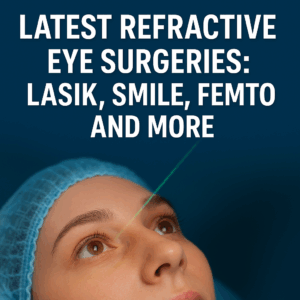
Anushka Super Speciality Eye Hospital
Call: 90044 44422 / 99213 44422 | Timings : 8.30 a.m to 5.30 p.m (Mon-Sat) | Add: Shri Swami Samarth Soc, Kaneri Dhamankar Naka, Bhiwandi




Accredited for Quality Care
Understanding Ptosis: Types, Signs, Symptoms & Effective Management
anushka
11 June 2025
Introduction
Ptosis, commonly known as droopy eyelid, is a condition that affects countless individuals worldwide. It’s more than just a cosmetic concern—it can impact vision, self-esteem, and daily life. If you’ve ever noticed your eyelid sagging or felt like one eye looks smaller than the other, you might be dealing with ptosis. In this blog, we’ll dive deep into what ptosis is, its types, signs, symptoms, and how it can be managed effectively. Whether you’re someone experiencing this condition or just curious to learn more, this guide is for you. Let’s explore this topic in a way that’s relatable, informative, and easy to understand.
What Is Ptosis?
Ptosis (pronounced “toe-sis”) refers to the drooping of the upper eyelid, where it sits lower than normal, sometimes covering part of the pupil. This can happen in one or both eyes and may range from mild to severe. While it’s often associated with aging, ptosis can affect people of all ages, including babies born with the condition. It’s caused by a weakness or dysfunction in the muscles or nerves responsible for lifting the eyelid, and in some cases, it’s linked to underlying health issues.
Types of Ptosis
Not all droopy eyelids are the same—ptosis comes in different forms depending on its cause. Here are the main types:
- Congenital Ptosis :
This type is present at birth. It happens when the levator muscle (the one that lifts the eyelid) doesn’t develop properly. Kids with congenital ptosis might tilt their heads back to see better, and if untreated, it can lead to lazy eye (amblyopia).
- Acquired Ptosis:
This develops later in life and is the most common type. It can be broken down further:
- Aponeurotic Ptosis: Often tied to aging, where the levator muscle’s tendon stretches or weakens over time.
- Neurogenic Ptosis: Caused by nerve issues, like in conditions such as Horner’s syndrome or third nerve palsy.
- Myogenic Ptosis: Linked to muscle diseases like myasthenia gravis, where the muscle itself weakens.
- Mechanical Ptosis: Occurs when something heavy, like a tumor or swelling, weighs the eyelid down.
- Traumatic Ptosis: Results from injury or surgery that damages the eyelid or its muscles.
Understanding the type of ptosis is key to finding the right treatment, so let’s move on to spotting it.
Signs and Symptoms of Ptosis
Ptosis isn’t always obvious at first glance—it can sneak up on you. Here’s what to look out for:
- Drooping Eyelid: The most noticeable sign. One or both eyelids may sag, sometimes covering part of the pupil.
- Vision Problems: If the eyelid blocks the pupil, it can blur or obstruct your sight.
- Tired Eyes: You might feel eye strain or fatigue from constantly lifting your brows to see better.
- Head Tilting: Especially in kids, tilting the head back to compensate for the droop is common.
- Asymmetry: One eye may look smaller or lower than the other.
- Dryness or Watery Eyes: The uneven eyelid position can mess with tear distribution.
For some, ptosis is a minor annoyance, but for others, it’s a real challenge. I remember a friend once telling me how she didn’t realize her droopy eyelid was affecting her vision until she started bumping into things on her left side—it was a wake-up call!
Causes Behind Ptosis
So, what causes this droop? It’s a mix of factors:
- Aging: The most common culprit—muscles and tissues weaken over time.
- Genetics: Congenital ptosis often runs in families.
- Medical Conditions: Diseases like diabetes, stroke, or myasthenia gravis can play a role.
- Injury: Trauma to the eye or surrounding area can damage muscles or nerves.
- Lifestyle: Rubbing your eyes too much or wearing contact lenses for years might contribute.
If you suspect ptosis, don’t brush it off—talking to a doctor can help pinpoint the cause.
Management and Treatment Options
The good news? Ptosis can often be managed or corrected. The approach depends on the severity, cause, and your personal needs. Here’s how it’s typically handled:
- Observation
For mild cases with no vision impact, doctors might suggest a “wait and see” approach, especially if it’s age-related and not bothersome.
- Glasses with Crutches
Special glasses with a small attachment (crutch) can prop up the eyelid. It’s a non-invasive option for those avoiding surgery.
- Surgery
The go-to fix for most cases is ptosis repair surgery:
- Levator Resection: Tightens the levator muscle to lift the lid.
- Frontalis Sling: Uses a tiny strap to connect the eyelid to the forehead muscle, common in severe congenital cases.
Recovery takes a few weeks, and while it’s generally safe, there’s a small risk of infection or asymmetry.
- Treating Underlying Conditions
If ptosis stems from a disease like myasthenia gravis, managing that condition with medication might help the droop.
- Lifestyle Adjustments
Avoiding eye strain, using lubricating drops, and being gentle with your eyes can ease symptoms.
I’ve heard from people who’ve had surgery that it’s life-changing—suddenly, they’re seeing the world in a whole new way. But it’s not a one-size-fits-all solution, so consult an eye specialist to weigh your options.
Living with Ptosis: A Human Perspective
Ptosis isn’t just medical—it’s personal. It can make you feel self-conscious or frustrated when people ask, “Are you tired?” all the time. But here’s the thing: you’re not alone. Many folks manage it with confidence, whether through treatment or simply owning their unique look. One person I know even turned her droopy eyelid into a signature feature with bold makeup—talk about turning a challenge into a strength!
Frequently Asked Questions (FAQs) About Ptosis
Here’s a quick rundown of common questions people ask about ptosis, with short, humanized answers:
1.What causes a droopy eyelid?
It could be aging, an injury, a medical condition, or something you’re born with—lots of possibilities!
2.Can ptosis go away on its own?
Not usually, especially if it’s congenital or age-related, but mild cases might improve if an underlying issue is treated.
3.Is ptosis surgery painful?
Most say it’s more uncomfortable than painful, and recovery is manageable with some rest and ice packs.
4.Can kids outgrow congenital ptosis?
Nope, it doesn’t just disappear, but surgery can fix it if it’s affecting vision or development.
5.How do I know if I need treatment?
If it’s blocking your sight or bothering you daily, see a doctor—otherwise, it might just be a quirky trait!
6.Does insurance cover ptosis surgery?
Often, yes, if it’s impacting vision—check with your provider to be sure.
7. Can ptosis come back after surgery?
It’s rare, but aging or new issues could cause a droop again down the line.
Conclusion
Ptosis might sound intimidating, but it’s a condition with solutions. Whether it’s a slight droop or a major obstruction, understanding your options can make all the difference. If you’re dealing with it, don’t hesitate to reach out to a healthcare pro—they’ll guide you toward what’s best for you. And hey, if you’ve got a droopy eyelid story, I’d love to hear it—because behind every case of ptosis is a person navigating it in their own way.
Recent Posts


